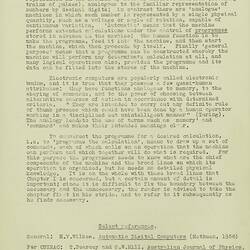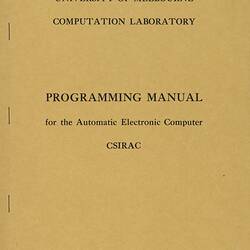CSIRAC is a general-purpose automatic electronic digital computer. The word electronic indicates that it uses electric circuits and valves. 'Digital' means that numbers are represented in the machine by sets of discrete entities (actually trains of pulses), analogous to the familiar representation of numbers by decimal digits. In contrast there are 'Analogue' machines in which each number is represented by a single physical quantity, such as a voltage or angle of rotation, capable of continuous variation. 'Automatic' means that the machine performs extended calculations under the control of programmes stored in advance in the machine. The human function is to make the programme, feed it into the machine, and then start the machine, which then proceeds by itself. Finally 'general purpose' means that a programme can be constructed whereby the machine will perform any determinate calculation at all, and many logical operations also, provided the programme and its data can be fitted into the stores of the machine.
Electronic computers are popularly called electronic brains, and it is true that they possess a few quasi-human attributes; they have functions analogous to memory, to the obeying of commands, and to the power of choosing between alternative courses of action in accordance with determined criteria. 'They are intended to carry out any definite rule of thumb process which could have been done by a human operator working in a disciplined but unintelligent manner' (Turing). The analogy leads to the use of terms such as 'memory' and 'command' and makes their intended meanings clear.
To construct the programme for a desired calculation, i.e. to 'programme the calculation', means to draw up a set of commands, each of which calls on an operation that the machine can perform and which together will do what is required. For this purpose, the programmer needs to know what are the chief components of the machine and the broad line on which its operation is organised, but he needs no detailed physical knowledge. It is on the whole with these broad lines that Chapter 1 is concerned, but a certain amount of detail is important; since it is difficult to fix the boundary between the necessary and the unnecessary, the reader is advised to take the chapter first in his stride, and refer to it subsequently as he finds necessary.
More Information
-
Keywords
-
Authors
University of Melbourne (The), Dr Trevor Pearcey, Geoff Hill, Frank Hirst, Professor Thomas M. Cherry
-
Article types



